Green Roofs as a Nature-Based Solution to Mitigate Urban Heating During a Heatwave Event in the City of Athens, Greece
Abstract
1. Introduction
2. Study Area—Synoptic Conditions
3. Materials and Methods
3.1. Green Roofs Categorization
3.2. Data and Model Configuration
3.3. Experimental Set-Up
4. Results
5. Conclusions
Author Contributions
Funding
Institutional Review Board Statement
Informed Consent Statement
Data Availability Statement
Acknowledgments
Conflicts of Interest
Abbreviations/Nomenclature
| BEM | Building Energy Model |
| BEP | Building Effect Parameterization |
| BH | Building Height |
| CLIMPACT | A national network for climate change |
| CR | Control Run |
| CV(RMSE) | Coefficient of Variation of the Root Mean Squared |
| ECMWF | European Centre for Medium-Range Weather Forecasts |
| EnergyPlus | Building energy simulation program |
| ERA5 | ECMWF Reanalysis v5 |
| GAA | Greater Area of Athens |
| GIS | Geographic Information System |
| GR | Green Roofs |
| HCG | Heat Capacity of the Ground (road) |
| HCR | Heat Capacity of the building’s Roof |
| HCW | Heat Capacity of the building’s Walls |
| HUA | Harokopio University of Athens |
| HW | Heat Wave |
| LCZ | Local Climate Zones |
| MODIS | Moderate Resolution Imaging Spectroradiometer |
| NCEP | National Centers for Environmental Prediction |
| NMBE | Normalized Mean Bias Error |
| NSE | Nash–Sutcliffe model Efficiency coefficient |
| RMSE | Root Mean Square Error |
| RRTM | Rapid Radiative Transfer Model |
| S1 | Scenario 1—grass 100% coverage |
| S2 | Scenario 2—sedum 100% coverage |
| S3 | Scenario 3—grass 50% coverage |
| SAG | Surface Albedo of the Ground (road) |
| SAR | Surface Albedo of the building’s Roof |
| SAW | Surface Albedo of the building’s Walls |
| SB | Sea Breeze |
| SEG | Surface Emissivity of the Ground (road) |
| SER | Surface Emissivity of the building’s Roof |
| SEW | Surface Emissivity of the building’s Walls |
| SRTM | NASA Shuttle Radar Topographic Mission |
| TCG | Thermal Conductivity of ground (road) |
| TCR | Thermal Conductivity of the building’s roof |
| TCW | Thermal Conductivity of the building’s Walls |
| TKE | Turbulent Kinetic Energy |
| TRNYS | Transient System Simulation Tool |
| UCM | Urban Canopy Model |
| UHeatEx | Urban Heat Exposure Index |
| UHI | Urban Heat Island |
| USGS | United States Geological Survey |
| USP | Urban Surface Properties |
| UTC | Coordinated Universal Time |
| WRF | Weather Research and Forecasting Model |
| WUDAPT | World Urban Database and Access Portal Tools |
References
- Stewart, I.D.; Oke, T.R. Local climate zones for urban temperature studies. Bull. Am. Meteorol. Soc. 2012, 93, 1879–1900. [Google Scholar] [CrossRef]
- Oke, T.R. The energetic basis of the urban heat island. Q. J. R. Meteorol. Soc. 1982, 108, 1–24. [Google Scholar] [CrossRef]
- Zhou, B.; Rybski, D.; Kropp, J.P. The role of city size and urban form in the surface urban heat island. Sci. Rep. 2017, 7, 4791. [Google Scholar] [CrossRef]
- Oke, T.R.; Johnson, G.T.; Steyn, D.G.; Watson, I.D. Simulation of surface urban heat islands under ‘ideal’ conditions at night part 2: Diagnosis of causation. Bound.-Layer Meteorol. 1991, 56, 339–358. [Google Scholar] [CrossRef]
- Santamouris, M. Cooling the cities—A review of reflective and green roof mitigation technologies to fight heat island and improve comfort in urban environments. Sol. Energy 2014, 103, 682–703. [Google Scholar] [CrossRef]
- Lhotka, O.; Kyselý, J.; Plavcová, E. Evaluation of major heat waves’ mechanisms in EURO-CORDEX RCMs over Central Europe. Clim. Dyn. 2018, 50, 4249–4262. [Google Scholar] [CrossRef]
- Founda, D.; Santamouris, M. Synergies between Urban Heat Island and Heat Waves in Athens (Greece), during an extremely hot summer (2012). Sci. Rep. 2017, 7, 10973. [Google Scholar] [CrossRef]
- Luber, G.; McGeehin, M. Climate change and extreme heat events. Am. J. Prev. Med. 2008, 35, 429–435. [Google Scholar] [CrossRef] [PubMed]
- Li, D.; Bou-Zeid, E. Synergistic interactions between urban heat islands and heat waves: The impact in cities is larger than the sum of its parts. J. Appl. Meteorol. Climatol. 2013, 52, 2051–2064. [Google Scholar] [CrossRef]
- Mathieu, R.; Freeman, C.; Aryal, J. Mapping private gardens in urban areas using object-oriented techniques and very high-resolution satellite imagery. Landsc. Urban Plan. 2007, 81, 179–192. [Google Scholar] [CrossRef]
- Smith, C. London: Garden City? Investigating the Changing Anatomy of London’s Private Gardens, and the Scale of Their Loss; London Wildlife Trust; Greenspace Information Greater London; Greater London Authority: London, UK, 2010.
- Ayata, T.; Tabares-Velasco, P.C.; Srebric, J. An investigation of sensible heat fluxes at a green roof in a laboratory setup. Build. Environ. 2011, 46, 1851–1861. [Google Scholar] [CrossRef]
- Dudorova, N.V.; Belan, B.D. The Energy Model of Urban Heat Island. Atmosphere 2022, 13, 457. [Google Scholar] [CrossRef]
- Sharma, A.; Conry, P.; Fernando, H.J.S.; Hamlet, A.F.; Hellmann, J.J.; Chen, F. Green and cool roofs to mitigate urban heat island effects in the Chicago metropolitan area: Evaluation with a regional climate model. Environ. Res. Lett. 2016, 11, 064004. [Google Scholar] [CrossRef]
- Theodosiou, T. Green roofs in buildings: Thermal and environmental behaviour. Adv. Build. Energy Res. 2009, 3, 271–288. [Google Scholar] [CrossRef]
- Li, X.X.; Norford, L.K. Evaluation of cool roof and vegetations in mitigating urban heat island in a tropical city, Singapore. Urban Clim. 2016, 16, 59–74. [Google Scholar] [CrossRef]
- Porcaro, M. Potential of Energy Demand Reduction in Buildings with Green Roofs Under Climatic Conditions of Southern Europe. Ph.D. Thesis, University of Cordoba, Cordoba, Spain, May 2021. [Google Scholar]
- Sailor, D.J.; Elley, T.B.; Gibson, M. Exploring the building energy impacts of green roof design decisions—A modeling study of buildings in four distinct climates. J. Build. Phys. 2011, 35, 372–391. [Google Scholar] [CrossRef]
- Yoshida, A.; Hisabayashi, T.; Kashihara, K.; Kinoshita, S.; Hashida, S. Evaluation of effect of tree canopy on thermal environment, thermal sensation, and mental state. Urban Clim. 2015, 14, 240–250. [Google Scholar] [CrossRef]
- Zhang, N.; Chen, Y.; Luo, L.; Wang, Y. Effectiveness of different urban heat island mitigation methods and their regional impacts. J. Hydrometeorol. 2017, 18, 2991–3012. [Google Scholar] [CrossRef]
- Imran, H.M.; Kala, J.; Ng, A.W.M.; Muthukumaran, S. Effectiveness of green and cool roofs in mitigating urban heat island effects during a heatwave event in the city of Melbourne in southeast Australia. J. Clean. Prod. 2018, 197, 393–405. [Google Scholar] [CrossRef]
- Morakinyo, T.E.; Dahanayake, K.K.C.; Ng, E.; Chow, C.L. Temperature and cooling demand reduction by green-roof types in different climates and urban densities: A co-simulation parametric study. Energy Build. 2017, 145, 226–237. [Google Scholar] [CrossRef]
- Georgescu, M.; Morefield, P.E.; Bierwagen, B.G.; Weaver, C.P. Urban adaptation can roll back warming of emerging megapolitan regions. Proc. Natl. Acad. Sci. USA 2014, 111, 2909–2914. [Google Scholar] [CrossRef] [PubMed]
- Jamei, E.; Chau, H.W.; Seyedmahmoudian, M.; Stojcevski, A. Review on the cooling potential of green roofs in different climates. Sci. Total Environ. 2021, 791, 148407. [Google Scholar] [CrossRef] [PubMed]
- Rafael, S.; Correia, L.P.; Ascenso, A.; Augusto, B.; Lopes, D.; Miranda, A.I. Are green roofs the path to clean air and low carbon cities? Sci. Total Environ. 2021, 798, 149313. [Google Scholar] [CrossRef] [PubMed]
- Voogt, J.A. Urban Heat Islands: Hotter Cities; America Institute of Biological Sciences: Herndon, VA, USA, 2004; pp. 4–7. [Google Scholar]
- University Corporation for Atmospheric Research. Urban Heat Islands. 2011. Available online: https://scied.ucar.edu/longcontent/urban-heat-islands (accessed on 3 November 2024).
- Agathangelidis, I.; Cartalis, C.; Santamouris, M. Integrating urban form, function, and energy fluxes in a heat exposure indicator in view of intra-urban Heat Island assessment and climate change adaptation. Climate 2019, 7, 75. [Google Scholar] [CrossRef]
- Mihalakakou, G.; Souliotis, M.; Papadaki, M.; Menounou, P.; Dimopoulos, P.; Kolokotsa, D.; Paravantis, J.A.; Tsangrassoulis, A.; Panaras, G.; Giannakopoulos, E.; et al. Green roofs as a nature-based solution for improving urban sustainability: Progress and perspectives. Renew. Sustain. Energy Rev. 2023, 180, 113306. [Google Scholar] [CrossRef]
- Tseliou, A.; Melas, E.; Mela, A.; Tsiros, I.; Zervas, E. The Effect of Green Roofs and Green Façades in the Pedestrian Thermal Comfort of a Mediterranean Urban Residential Area. Atmosphere 2023, 14, 1512. [Google Scholar] [CrossRef]
- Iaria, J.; Susca, T. Analytic Hierarchy Processes (AHP) evaluation of green roof-and green wall-based UHI mitigation strategies via ENVI-met simulations. Urban Clim. 2022, 46, 101293. [Google Scholar] [CrossRef]
- Scolaro, T.P.; Ghisi, E.; Silva, C.M. Assessing the impact of evapotranspiration from green roofs on reducing surface temperatures. J. Build. Eng. 2024, 95, 110095. [Google Scholar] [CrossRef]
- Göç Yener, Ü. Green Roof as an Element of Green Infrastructure and Inferences for Implementations in Turkey. Master’s Thesis, Middle East Technical University, Ankara, Türkiye, 2021. [Google Scholar]
- Zhao, L.; Oppenheimer, M.; Zhu, Q.; Baldwin, J.W.; Ebi, K.L.; Bou-Zeid, E.; Guan, K.; Liu, X. Interactions between urban heat islands and heat waves. Environ. Res. Lett. 2018, 13, 034003. [Google Scholar] [CrossRef]
- Dimitriadou, L.; Zerefos, C. Heatwaves and Mortality in Spain and Greece: A Comparative Analysis. Atmosphere 2023, 14, 766. [Google Scholar] [CrossRef]
- Pantavou, K.; Kotroni, V.; Kyros, G.; Lagouvardos, K. Thermal bioclimate in Greece based on the Universal Thermal Climate Index (UTCI) and insights into 2021 and 2023 heatwaves. Theor. Appl. Climatol. 2024, 155, 6661–6675. [Google Scholar] [CrossRef]
- Guerreiro, S.B.; Dawson, R.J.; Kilsby, C.; Lewis, E.; Ford, A. Future heat-waves, droughts and floods in 571 European cities. Environ. Res. Lett. 2018, 13, 034009. [Google Scholar] [CrossRef]
- Smid, M.; Russo, S.; Costa, A.C.; Granell, C.; Pebesma, E. Ranking European capitals by exposure to heat waves and cold waves. Urban Clim. 2009, 27, 388–402. [Google Scholar] [CrossRef]
- Founda, D. Urban thermal risk. Atmosphere 2021, 12, 466. [Google Scholar] [CrossRef]
- Dandou, A.; Papangelis, G.; Kontos, Τ.; Santamouris, M.; Tombrou, M. On the cooling potential of urban heating mitigation technologies in a coastal temperate city. Landsc. Urban Plan. 2021, 212, 104106. [Google Scholar] [CrossRef]
- Martilli, A.; Clappier, A.; Rotach, M.W. An urban surface exchange parameterisation for mesoscale models. Bound.-Layer Meteorol. 2002, 104, 261–304. [Google Scholar] [CrossRef]
- Salamanca, F.; Krpo, A.; Martilli, A.; Clappier, A. A new building energy model coupled with an urban canopy parameterization for urban climate simulations—Part I. formulation, verification, and sensitivity analysis of the model. Theor. Appl. Climatol. 2010, 99, 331–344. [Google Scholar] [CrossRef]
- Giovannini, L.; Zardi, D.; De Franceschi, M.; Chen, F. Numerical simulations of boundary-layer processes and urban-induced alterations in an Alpine valley. Int. J. Climatol. 2014, 34, 1111–1131. [Google Scholar] [CrossRef]
- Salamanca, F.; Zhang, Y.; Barlage, M.; Chen, F.; Mahalov, A.; Miao, S. Evaluation of the WRF-urban modeling system coupled to Noah and Noah-MP land surface models over a semiarid urban environment. J. Geophys. Res. Atmos. 2018, 123, 2387–2408. [Google Scholar] [CrossRef]
- Zonato, A.; Martilli, A.; Gutierrez, E.; Chen, F.; He, C.; Barlage, M.; Zardi, D.; Giovannini, L. Exploring the effects of rooftop mitigation strategies on urban temperatures and energy consumption. J. Geophys. Res. Atmos. 2021, 126, e2021JD035002. [Google Scholar] [CrossRef]
- Pappaccogli, G.; Giovannini, L.; Zardi, D.; Martilli, A. Assessing the Ability of WRF-BEP+ BEM in Reproducing the Wintertime Building Energy Consumption of an Italian Alpine City. J. Geophys. Res. Atmos. 2021, 126, e2020JD033652. [Google Scholar] [CrossRef]
- Giannaros, C.; Nenes, A.; Giannaros, T.M.; Kourtidis, K.; Melas, D. A comprehensive approach for the simulation of the Urban Heat Island effect with the WRF/SLUCM modeling system: The case of Athens (Greece). Atmos. Res. 2018, 201, 86–101. [Google Scholar] [CrossRef]
- Ribeiro, I.; Martilli, A.; Falls, M.; Zonato, A.; Villalba, G. Highly resolved WRF-BEP/BEM simulations over Barcelona urban area with LCZ. Atmos. Res. 2021, 248, 105220. [Google Scholar] [CrossRef]
- Zonato, A.; Martilli, A.; Di Sabatino, S.; Zardi, D.; Giovannini, L. Evaluating the performance of a novel WUDAPT averaging technique to define urban morphology with mesoscale models. Urban Clim. 2020, 31, 100584. [Google Scholar] [CrossRef]
- Molnár, G.; Gyöngyösi, A.Z.; Gál, T. Integration of an LCZ-based classification into WRF to assess the intra-urban temperature pattern under a heatwave period in Szeged, Hungary. Theor. Appl. Climatol. 2019, 138, 1139–1158. [Google Scholar] [CrossRef]
- Hammerberg, K.; Brousse, O.; Martilli, A.; Mahdavi, A. Implications of employing detailed urban canopy parameters for mesoscale climate modelling: A comparison between WUDAPT and GIS databases over Vienna, Austria. Int. J. Climatol. 2018, 38, e1241–e1257. [Google Scholar] [CrossRef]
- Giannaros, C.; Agathangelidis, I.; Papavasileiou, G.; Galanaki, E.; Kotroni, V.; Lagouvardos, K.; Giannaros, T.M.; Cartalis, C.; Matzarakis, A. The extreme heat wave of July–August 2021 in the Athens urban area (Greece): Atmospheric and human-biometeorological analysis exploiting ultra-high resolution numerical modeling and the local climate zone framework. Sci. Total Environ. 2023, 857, 159300. [Google Scholar] [CrossRef]
- Dandou, A.; Tombrou, M.; Soulakellis, N. The Influence of the City of Athens on the Evolution of the Sea-Breeze Front. Bound.-Layer Meteorol. 2009, 131, 35–51. [Google Scholar] [CrossRef]
- Tombrou, M.; Bossioli, E.; Kalogiros, J.; Allan, J.D.; Bacak, A.; Biskos, G.; Coe, H.; Dandou, A.; Kouvarakis, G.; Mihalopoulos, N.; et al. Physical and chemical processes of air masses in the Aegean Sea during Etesians: Aegean-GAME airborne campaign. Sci. Total Environ. 2015, 506, 201–216. [Google Scholar] [CrossRef]
- Founda, D.; Mamara, A.; Argiriou, A.; Pierros, F.; Sarantopoulos, A. Spatial and Temporal Changes of Diurnal Temperature Range in Greece—The Urban Effect. Environ. Sci. Proc. 2023, 26, 1. [Google Scholar] [CrossRef]
- Founda, D.; Katavoutas, G.; Pierros, F.; Mihalopoulos, N. The Extreme Heat Wave of Summer 2021 in Athens (Greece): Cumulative Heat and Exposure to Heat Stress. Sustainability 2022, 14, 7766. [Google Scholar] [CrossRef]
- Getter, K.L.; Rowe, D.B. The role of extensive green roofs in sustainable development. HortScience 2006, 41, 1276–1285. [Google Scholar] [CrossRef]
- Carter, T.; Butler, C. Ecological impacts of replacing traditional roofs with green roofs in two urban areas. Cities Environ. CATE 2008, 1, 9. Available online: https://digitalcommons.lmu.edu/cate/vol1/iss2/9 (accessed on 3 November 2024).
- Durhman, A.K.; Rowe, D.B.; Rugh, C.L. Effect of watering regimen on chlorophyll fluorescence and growth of selected green roof plant taxa. HortScience 2006, 41, 1623–1628. [Google Scholar] [CrossRef]
- De Munck, C.S.; Lemonsu, A.; Bouzouidja, R.; Masson, V.; Claverie, R. The GREENROOF module (v7. 3) for modelling green roof hydrological and energetic performances within TEB. Geosci. Model Dev. 2013, 6, 1941–1960. [Google Scholar] [CrossRef]
- Masson, V.; Champeaux, J.; Chauvin, F.; Meriguet, C.; Lacaze, R. A Global Database of Land Surface Parameters at 1-km Resolution in Meteorological and Climate Models. J. Clim. 2003, 16, 1261–1282. [Google Scholar] [CrossRef]
- Skamarock, W.C.; Klemp, J.B.; Dudhia, J.; Gill, D.O.; Liu, Z.; Berner, J.; Wang, W.; Powers, J.G.; Duda, M.G.; Barker, D.M.; et al. A Description of the Advanced Research WRF Model Version 4; National Center for Atmospheric Research: Boulder, CO, USA, 2019. [Google Scholar]
- Zhu, D.; Ooka, R. WRF-based scenario experiment research on urban heat island: A review. Urban Clim. 2023, 49, 101512. [Google Scholar] [CrossRef]
- Demuzere, M.; Argüeso, D.; Zonato, A.; Kittner, J. W2W: A Python package that injects WUDAPT’s Local Climate Zone information in WRF. J. Open Source Softw. 2022, 7, 4432. [Google Scholar] [CrossRef]
- Mitchel, A. The ESRI Guide to GIS Analysis, Volume 2: Spartial Measurements and Statistics; ESRI Press: Redlands, CA, USA, 2005. [Google Scholar]
- Janjic, Z.I.; Gerrity, J.P.; Nickovic, S. An alternative approach to nonhydrostatic modeling. Mon. Weather Rev. 2001, 129, 1164–1178. [Google Scholar] [CrossRef]
- Monin, A.S.; Obukhov, A.M. Basic Laws of Turbulent Mixing in the Surface Layer of the Atmosphere. Contrib. Geophys. Inst. Acad. Sci. USSR 1954, 24, 163–187. [Google Scholar]
- Janjić, Z.I. The step-mountain eta coordinate model: Further developments of the convection, viscous sublayer, and turbulence closure schemes. Mon. Weather Rev. 1994, 122, 927–945. [Google Scholar] [CrossRef]
- Iacono, M.J.; Mlawer, E.J.; Clough, S.A.; Morcrette, J.J. Impact of an improved longwave radiation model, RRTM, on the energy budget and thermodynamic properties of the NCAR community climate model, CCM3. J. Geophys. Res. Atmos. 2000, 105, 14873–14890. [Google Scholar] [CrossRef]
- Liang, T.; He, J.; Chen, L.; Yao, Z.; Zhang, L.; Che, H.; Gong, S. Simulation of the influence of a fine-scale urban underlying surface on the urban heat island effect in Beijing. Atmos. Res. 2021, 262, 105786. [Google Scholar] [CrossRef]
- Zhao, L.; Lee, X.; Smith, R.B.; Oleson, K. Strong contributions of local background climate to urban heat islands. Nature 2014, 511, 216–219. [Google Scholar] [CrossRef]
Disclaimer/Publisher’s Note: The statements, opinions, and data contained in all publications are solely those of the individual author(s) and contributor(s) and not of MDPI and/or the editor(s). MDPI and/or the editor(s) disclaim responsibility for any injury to people or property resulting from any ideas, methods, instructions, or products referred to in the content. |
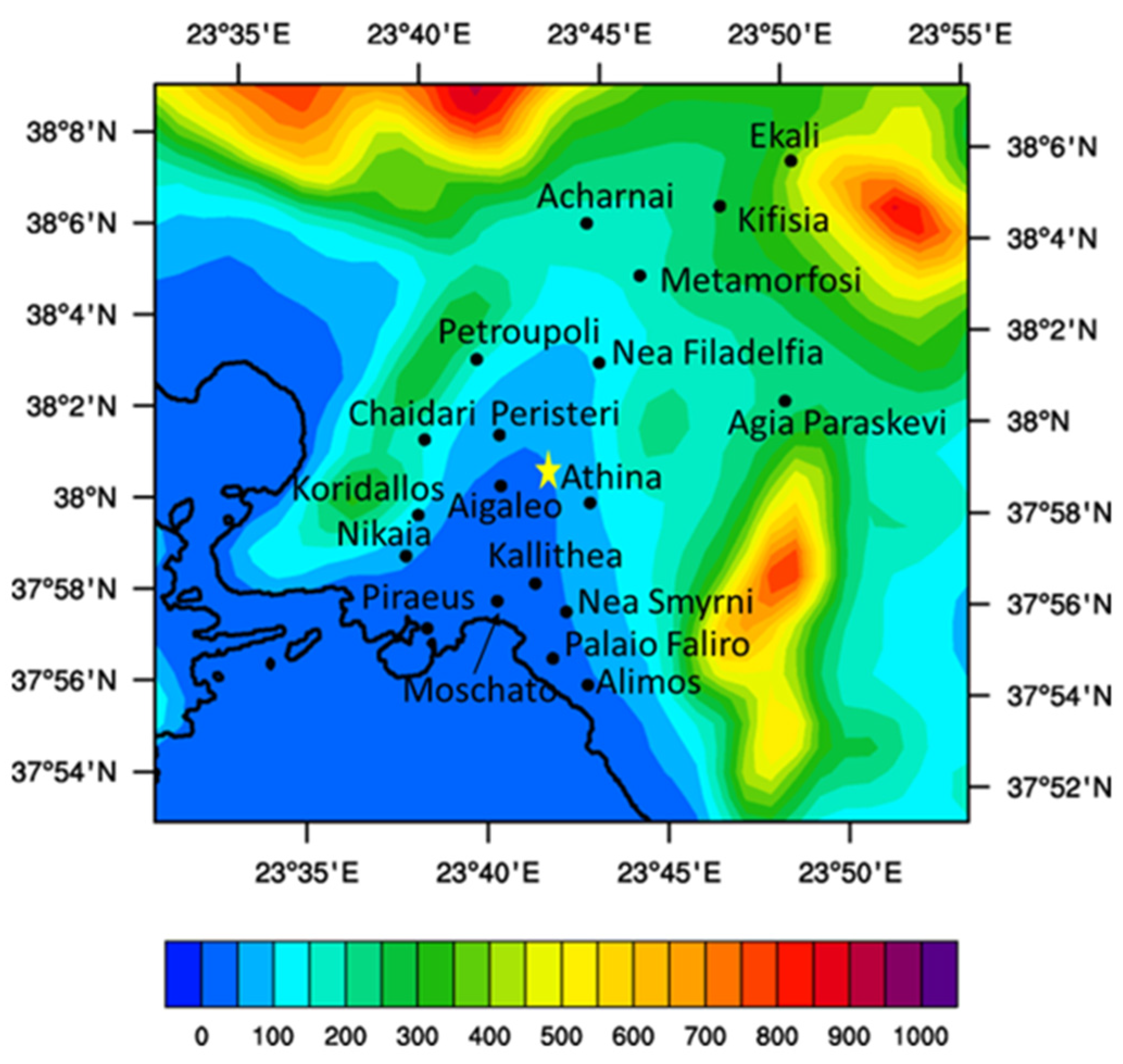
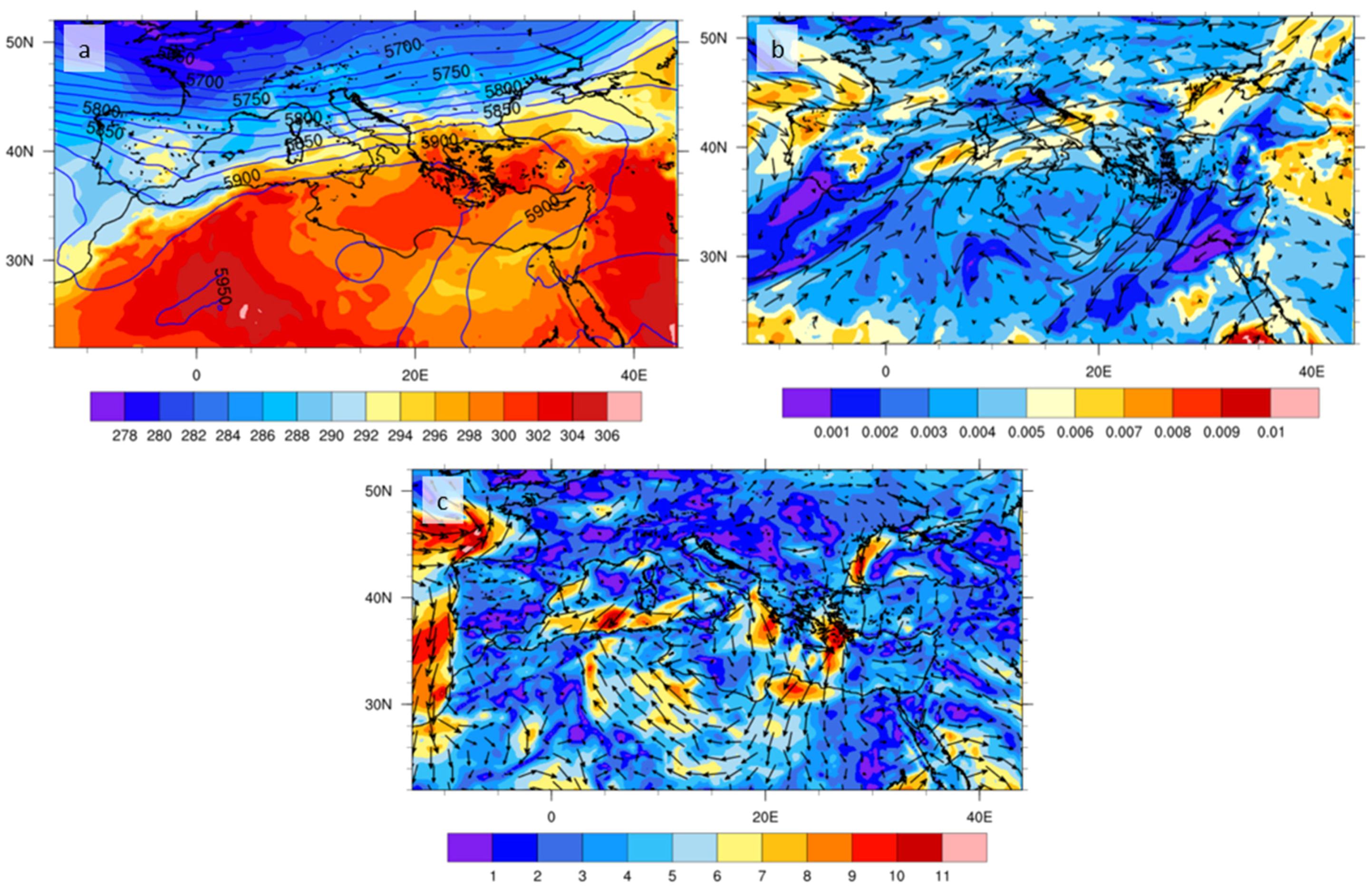
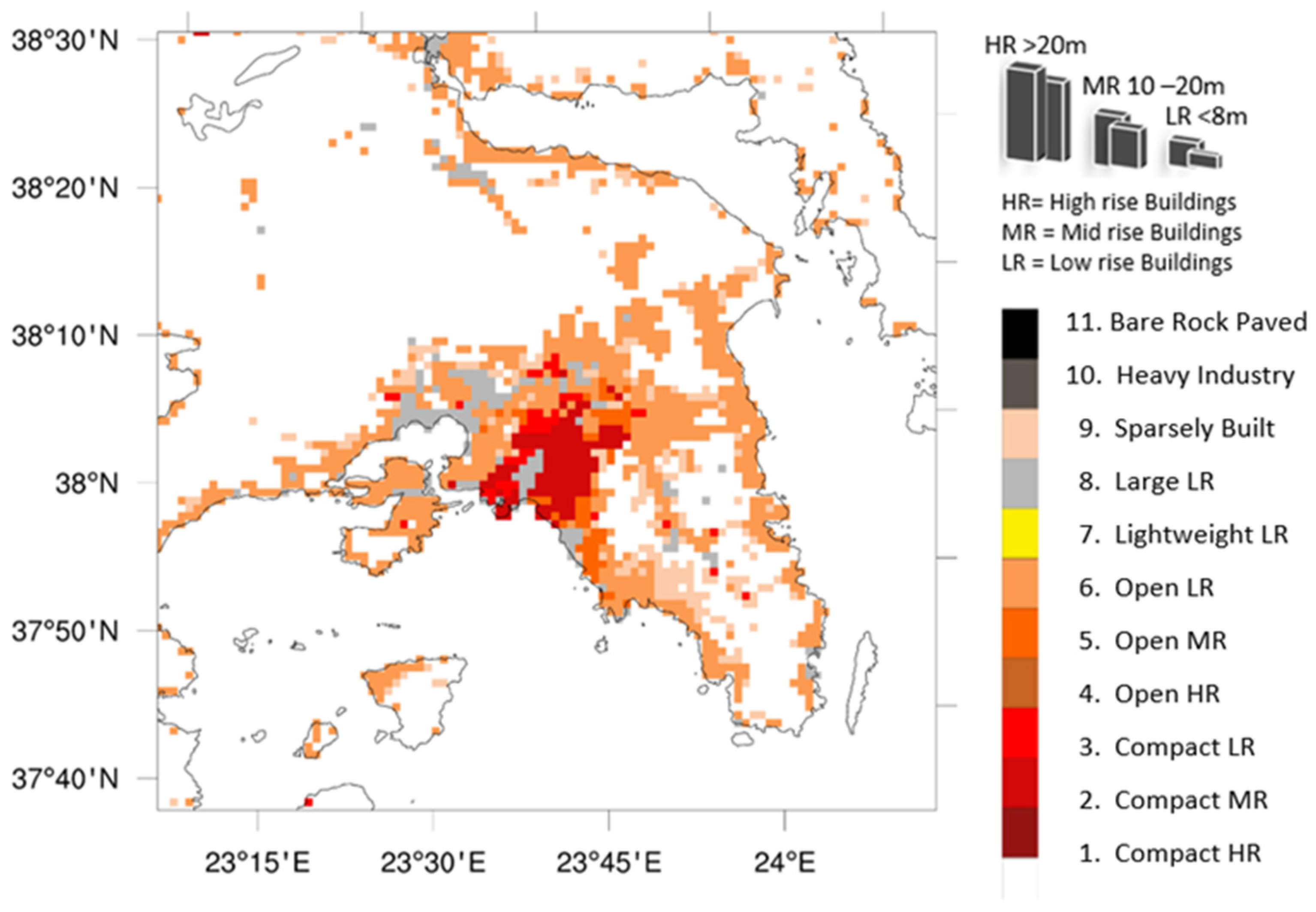
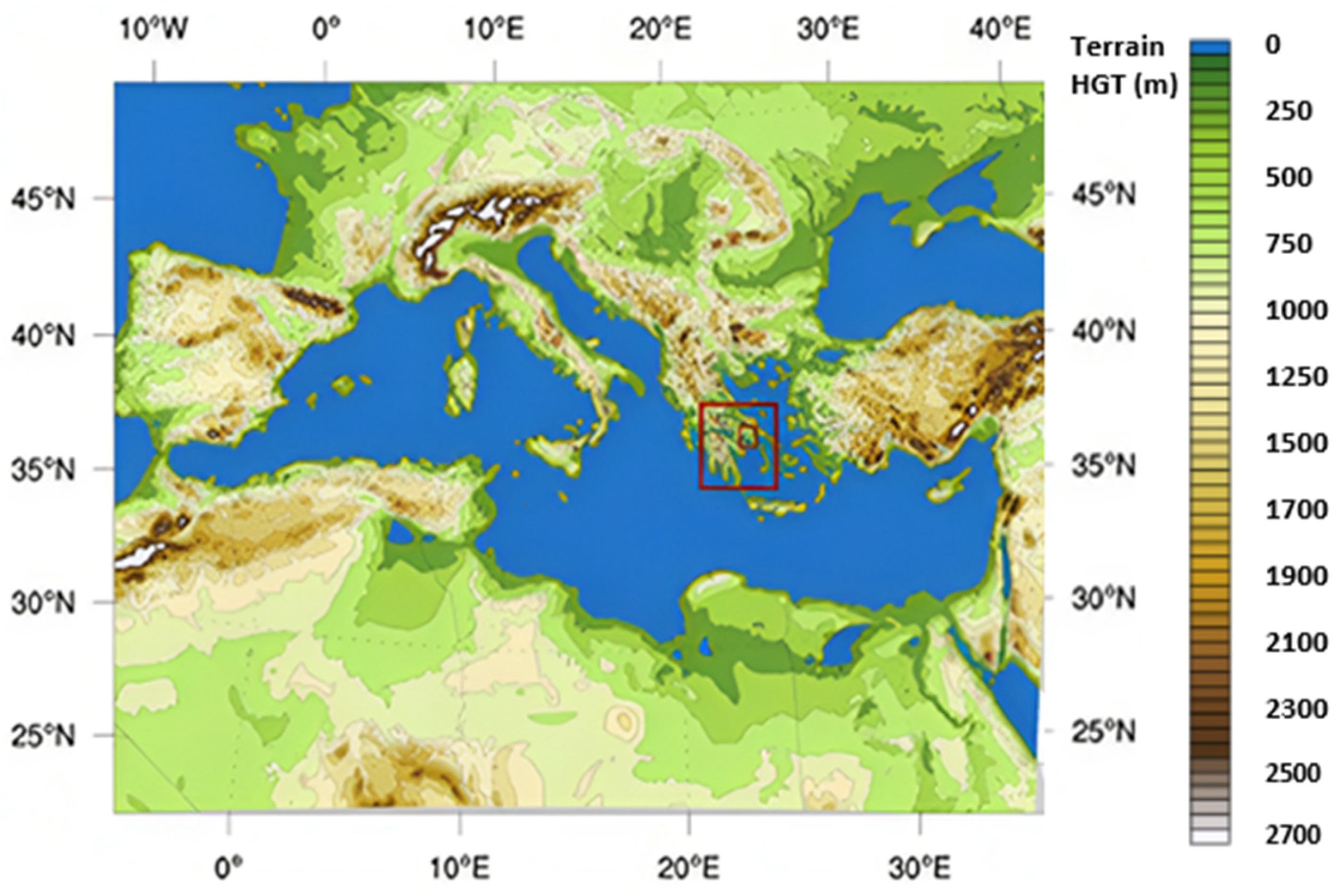

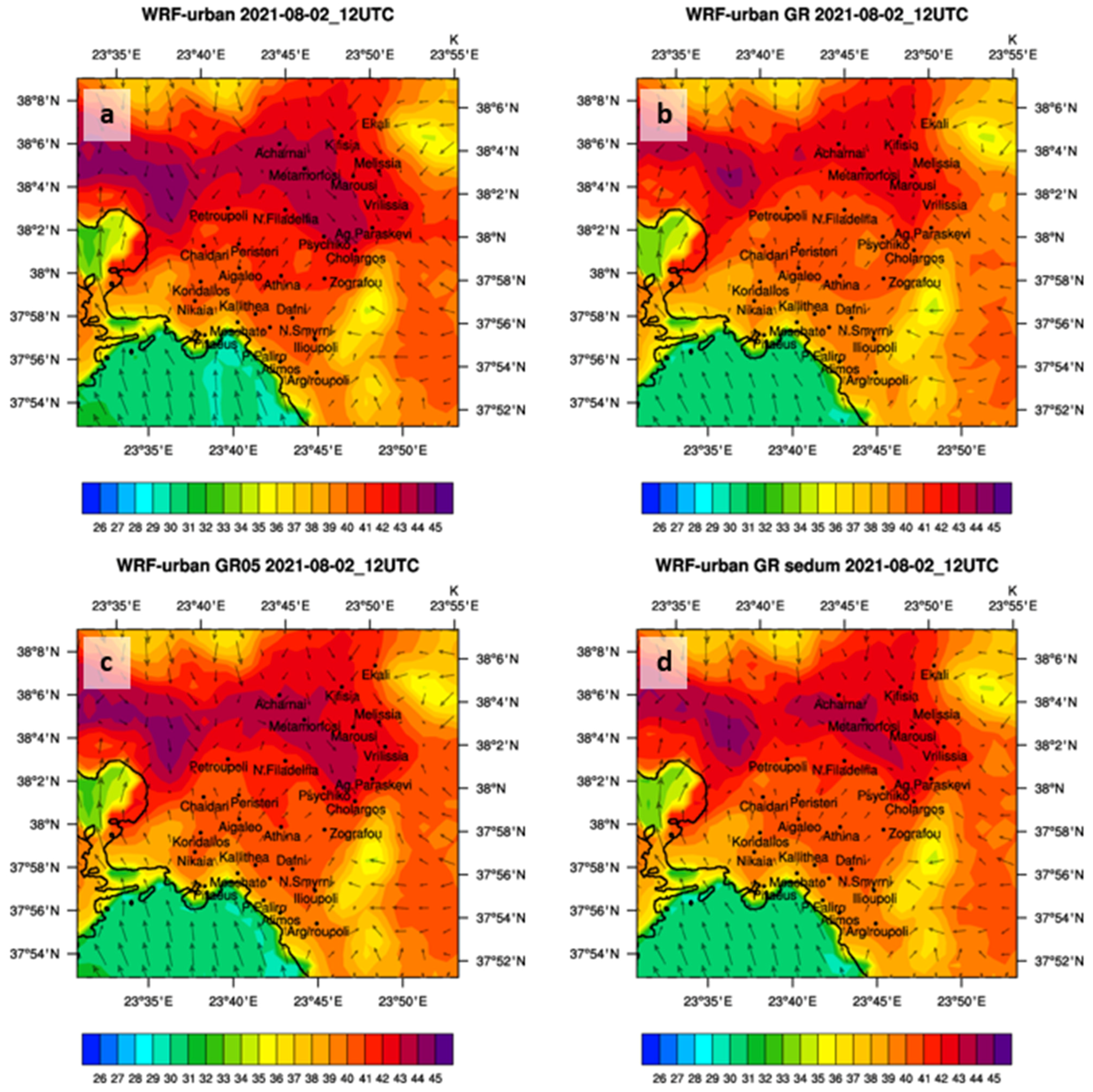

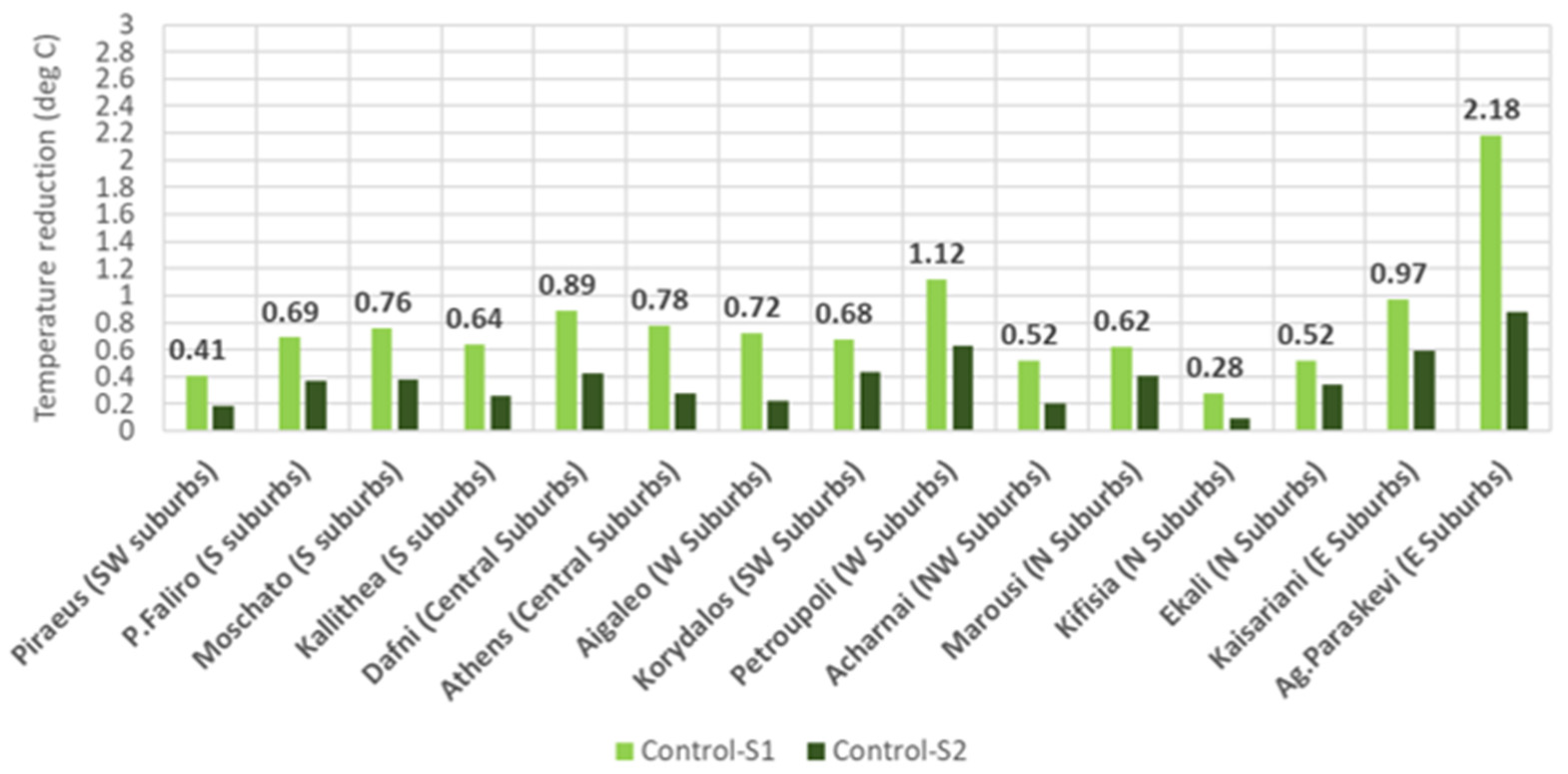
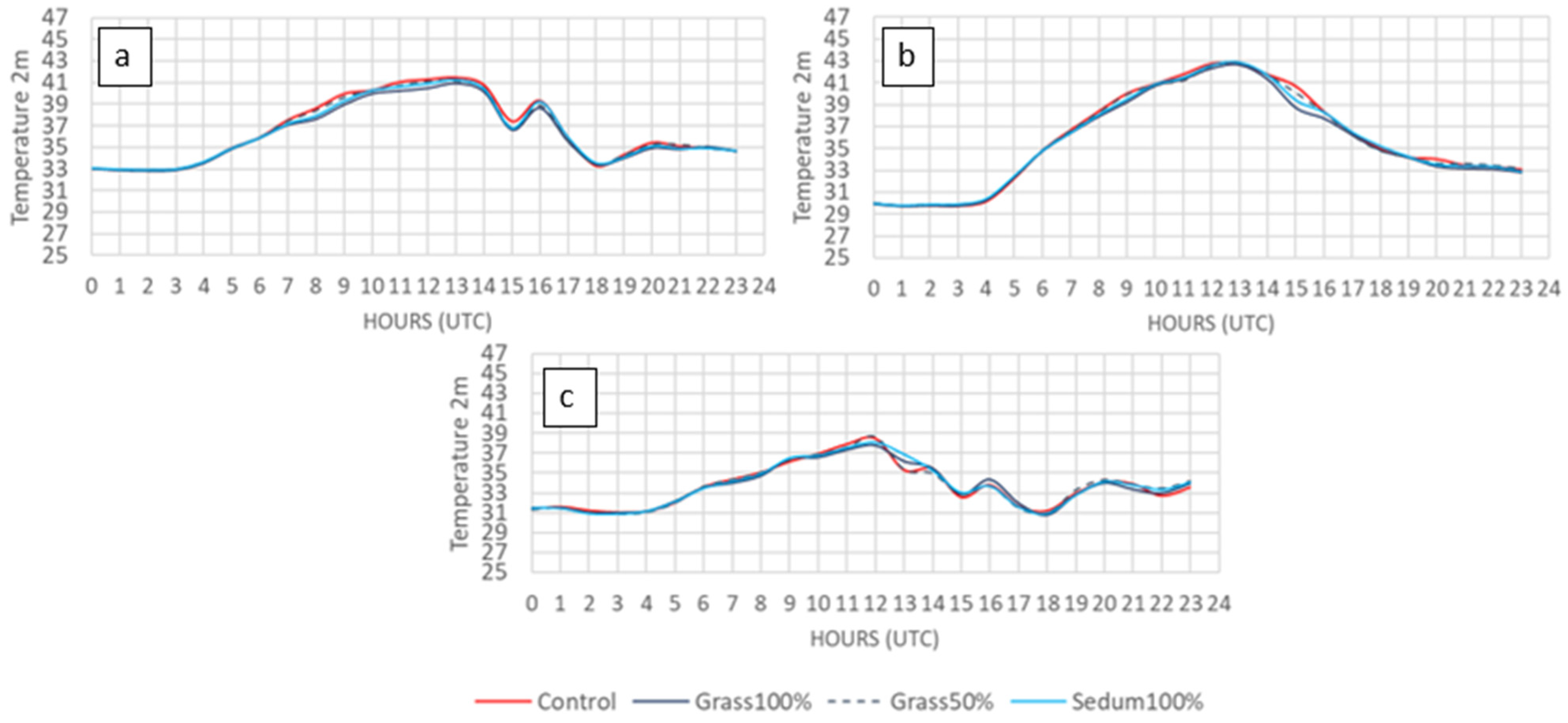

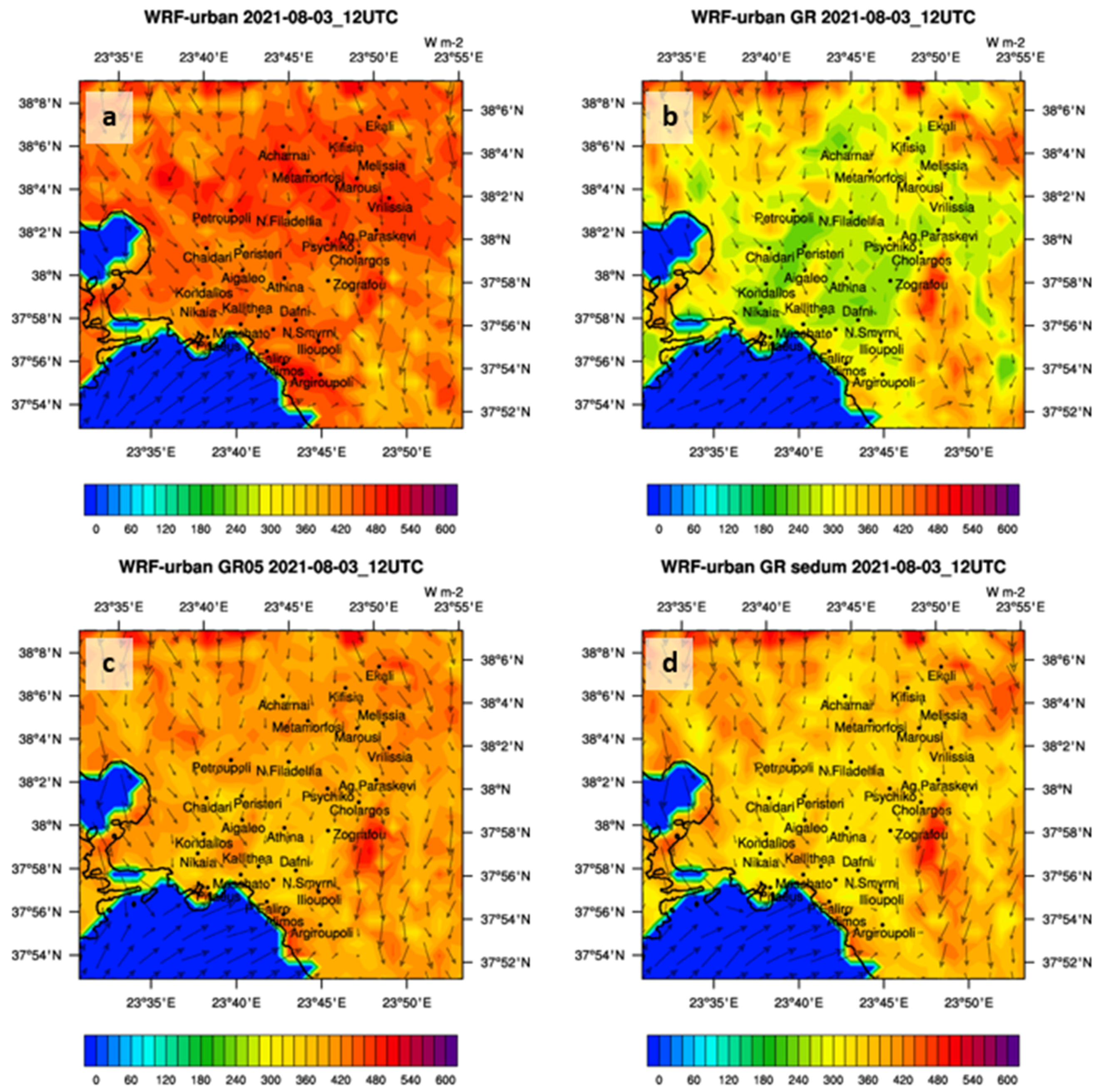
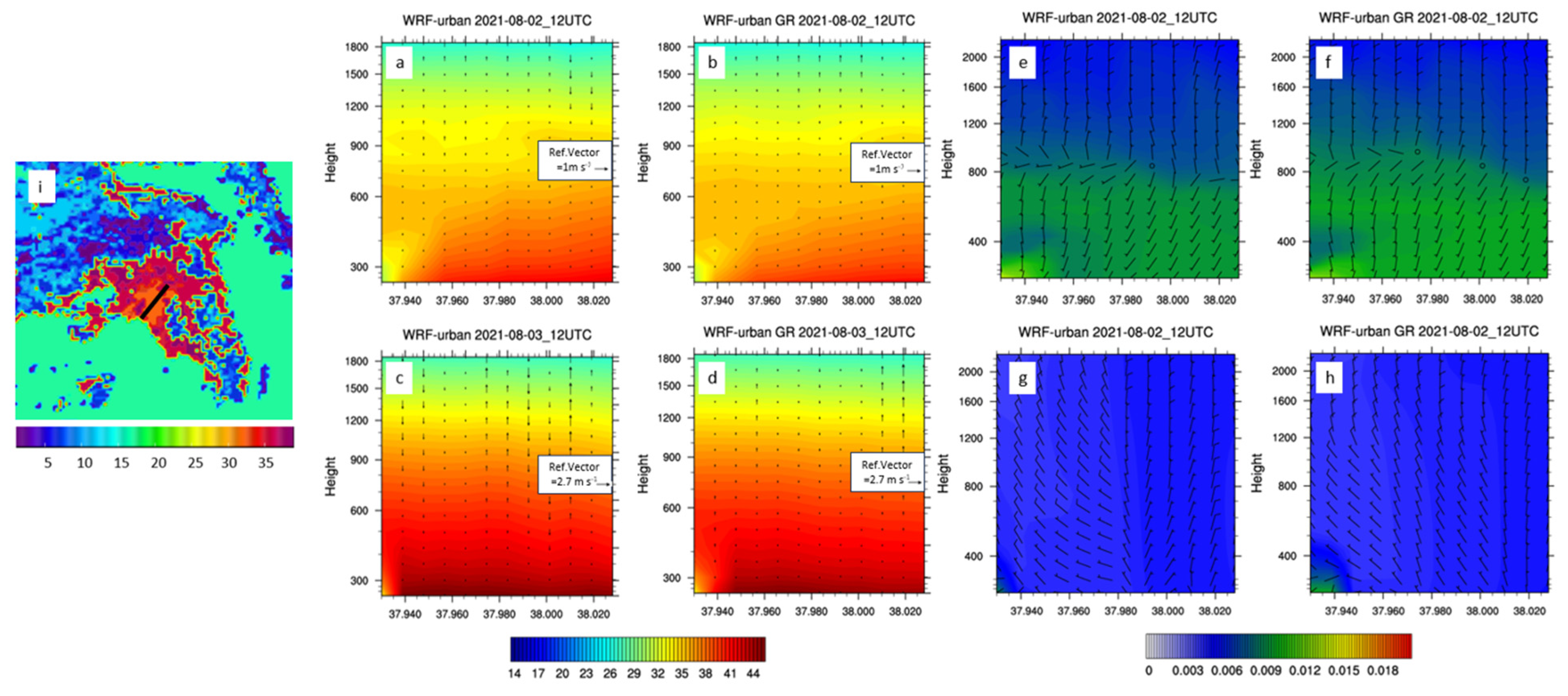

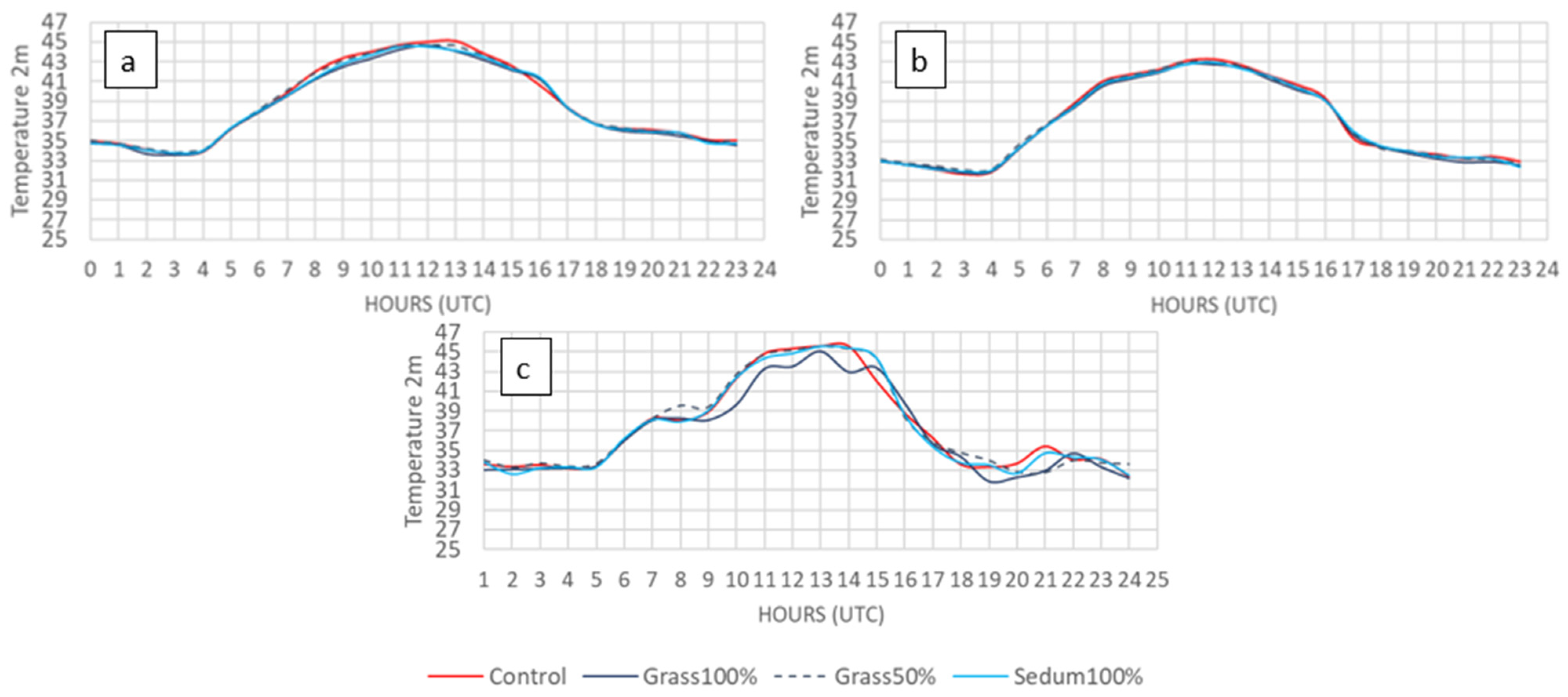
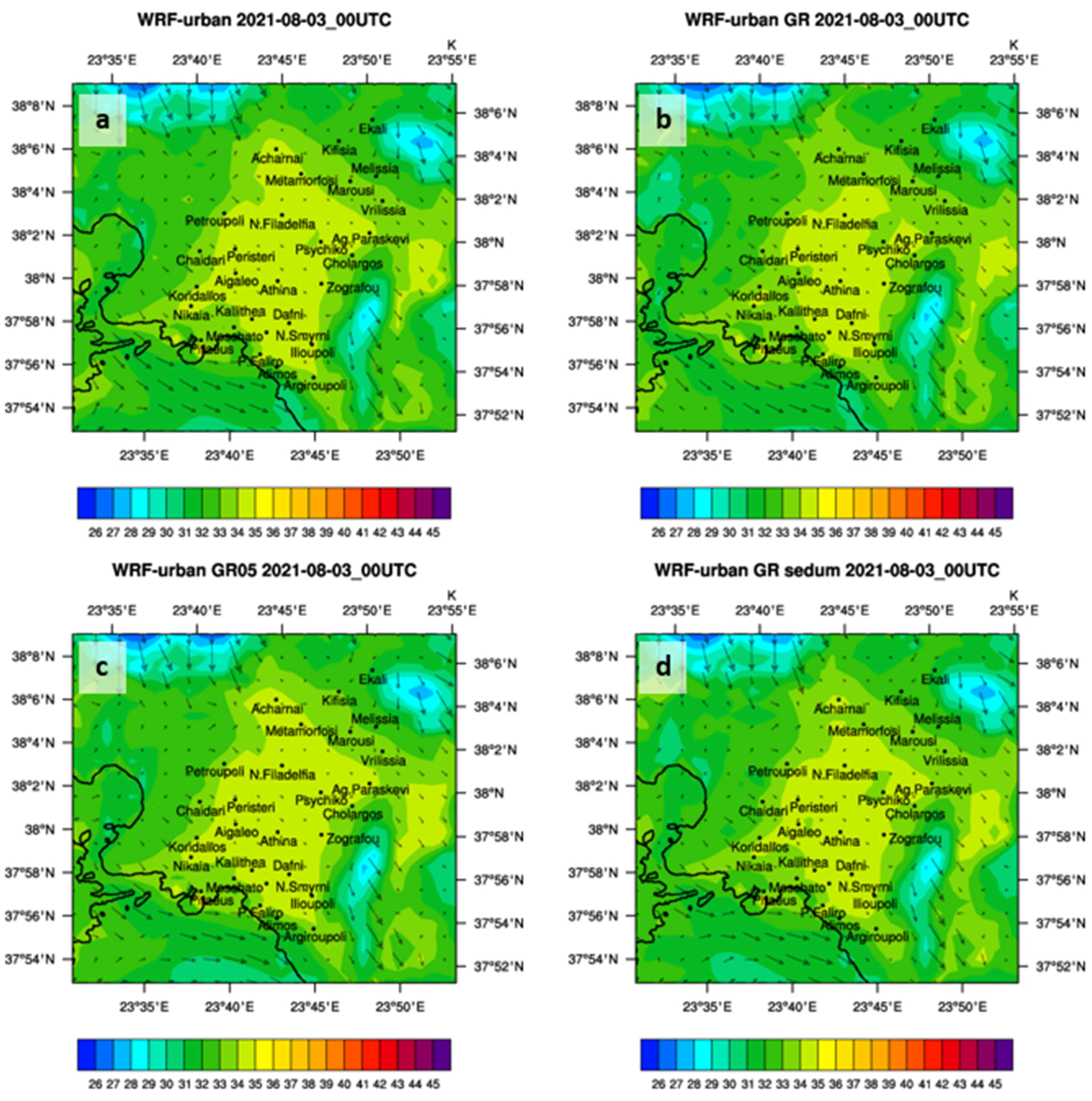
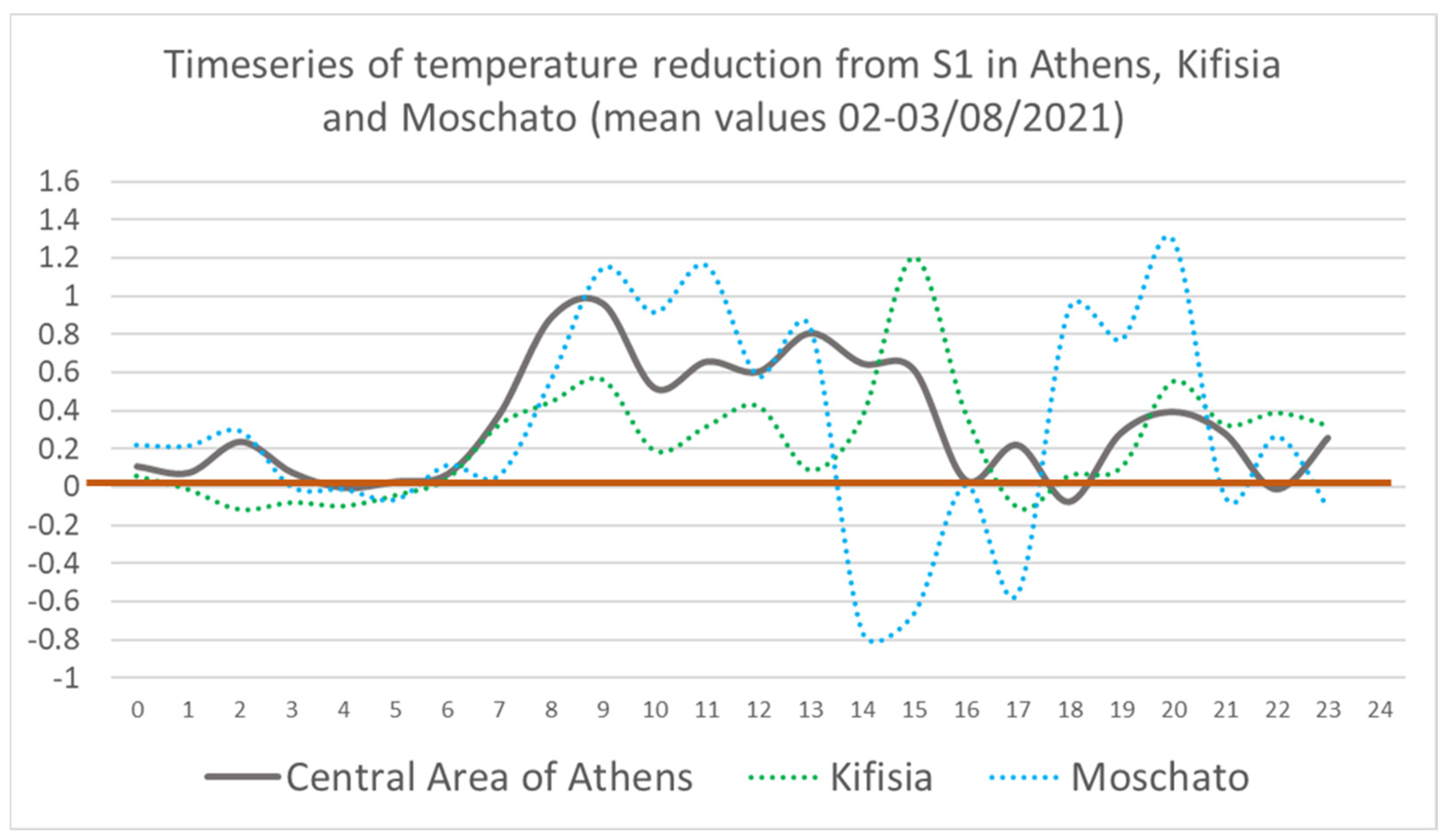
| Green Roof Parameters | Grass | Sedum |
|---|---|---|
| Leaf Area Index (LAI) | 2 | 3 |
| Albedo | 0.3 | 0.15 |
| Emissivity | 0.95 | 0.83 |
| Minimal stomatal resistance | 40 | 150 |
| WRF-Urban Classes | LCZ Classes | LCZ Characterization |
|---|---|---|
| 31 | LCZ1 | Compact high-rise |
| 32 | LCZ2 | Compact mid-rise |
| 33 | LCZ3 | Compact low-rise |
| 34 | LCZ4 | Open high-rise |
| 35 | LCZ5 | Open mid-rise |
| 36 | LCZ6 | Open low-rise |
| 37 | LCZ7 | Lightweight low-rise |
| 38 | LCZ8 | Large low-rise |
| 39 | LCZ9 | Sparsely built |
| 40 | LCZ10 | Heavy industry |
| 41 | LCZE11 | Rock and paved 1 |
| Physical Parameterizations | |
| Land-surface model | Νoah–MP (NCEP/Oregon State University/Air Force/Hydrologic Research Lab) [65] |
| Boundary-layer processes | Mellor–Yamada–Janjic TKE scheme [66] |
| Surface-layer processes | Monin–Obukhov (Janjic) scheme [67,68] |
| Urban processes | BEP/BEM parameterization [41,42,65]—The urban scheme used only for the innermost domain |
| Radiation (sw and lw) | RRTM scheme [69] |
| Input Data | |
| Land use—Urban areas | CLIMPACT—LCZ [28] for Athens MODIS for the rest of the domain |
| Sea surface temperature | Analysis from Copernicus Marine Environment Monitoring Service (CMEMS) Resolution 0.083° × 0.083° |
| Topography | (a) United States Geological Survey (USGS, 30 arcsec × 30 arcsec), (b) NASA Shuttle Radar Topographic Mission (SRTM, 3 arcsec × 3 arcsec). |
| GR Scenarios for the Attica Region | |
|---|---|
| Control run (CR) | No vegetation |
| Scenario 1 (S1) | 100% total coverage with grass |
| Scenario 2 (S2) | 100% total coverage with sedum |
| Scenario 3 (S3) | 50% total coverage with grass |
| Urban Parameters | LCZ2 | LCZ3 | LCZ5 | LCZ6 | LCZ8 | LCZ9 |
|---|---|---|---|---|---|---|
| BH Units: (m) | 17.5 | 6.5 | 17.5 | 6.5 | 6.5 | 6.5 |
| TCR/TCW/TCG Units: (MJ m−1 s−1 K−1) | 1.25/1.5/0.73 | 1/1.25/0.69 | 1.25/1.45/0.62 | 1/1.25/0.6 | 1.25/1.25/0.51 | 1/1/0.55 |
| HCR/HCW/HCG Units: (MJ m−3 K−1) | 1.8/2.67/1.68 | 1.44/2.05/1.63 | 1.8/2/1.5 | 1.44/2.05/1.47 | 1.8/1.8/1.38 | 1.44/2.56/1.37 |
| SAR/SAW/SAG Units: - | 0.18/0.2/0.14 | 0.15/0.2/0.14 | 0.13/0.25/0.14 | 0.13/0.25/0.14 | 0.18/0.25/0.14 | 0.13/0.25/0.14 |
| SER/SEW/SEG Units: - | 0.91/0.9/0.95 | 0.91/0.9/0.95 | 0.91/0.9/0.95 | 0.91/0.9/0.95 | 0.91/0.9/0.95 | 0.91/0.9/0.95 |
Disclaimer/Publisher’s Note: The statements, opinions and data contained in all publications are solely those of the individual author(s) and contributor(s) and not of MDPI and/or the editor(s). MDPI and/or the editor(s) disclaim responsibility for any injury to people or property resulting from any ideas, methods, instructions or products referred to in the content. |
© 2024 by the authors. Licensee MDPI, Basel, Switzerland. This article is an open access article distributed under the terms and conditions of the Creative Commons Attribution (CC BY) license (https://creativecommons.org/licenses/by/4.0/).
Share and Cite
Spyrou, C.; Koukoula, M.; Saviolakis, P.-M.; Zerefos, C.; Loupis, M.; Masouras, C.; Pappa, A.; Katsafados, P. Green Roofs as a Nature-Based Solution to Mitigate Urban Heating During a Heatwave Event in the City of Athens, Greece. Sustainability 2024, 16, 9729. https://doi.org/10.3390/su16229729
Spyrou C, Koukoula M, Saviolakis P-M, Zerefos C, Loupis M, Masouras C, Pappa A, Katsafados P. Green Roofs as a Nature-Based Solution to Mitigate Urban Heating During a Heatwave Event in the City of Athens, Greece. Sustainability. 2024; 16(22):9729. https://doi.org/10.3390/su16229729
Chicago/Turabian StyleSpyrou, Christos, Marika Koukoula, Pantelis-Manolis Saviolakis, Christos Zerefos, Michael Loupis, Charis Masouras, Aikaterini Pappa, and Petros Katsafados. 2024. "Green Roofs as a Nature-Based Solution to Mitigate Urban Heating During a Heatwave Event in the City of Athens, Greece" Sustainability 16, no. 22: 9729. https://doi.org/10.3390/su16229729
APA StyleSpyrou, C., Koukoula, M., Saviolakis, P.-M., Zerefos, C., Loupis, M., Masouras, C., Pappa, A., & Katsafados, P. (2024). Green Roofs as a Nature-Based Solution to Mitigate Urban Heating During a Heatwave Event in the City of Athens, Greece. Sustainability, 16(22), 9729. https://doi.org/10.3390/su16229729









